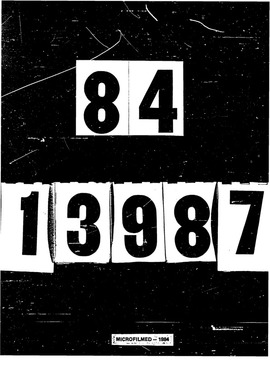| dc.contributor.author | Watkins, Alice Jan, | en_US |
| dc.date.accessioned | 2013-08-16T12:29:03Z | |
| dc.date.available | 2013-08-16T12:29:03Z | |
| dc.date.issued | 1984 | en_US |
| dc.identifier.uri | https://hdl.handle.net/11244/5219 | |
| dc.description.abstract | The study employed twenty-two third semester class piano students. The subjects were assigned randomly to experimental and control groups. Both groups were involved with this experiment for fifteen minutes of each class period for the ten-week study. One group was taught to sight read accompaniments by a traditional procedure; in the other group accompaniments were performed with a tape-recorded soloist. A pretest-posttest research design was used to determine whether significant differences developed between the sight reading skills of the two groups as a result of the two differing treatments. | en_US |
| dc.description.abstract | Three measured achievements were tested in the experiment, pitch accuracy, rhythm accuracy, and expression accuracy. The null hypotheses for the study were tested by the Student's t test (a parametric test), the Mann-Whitney U test (a nonparametric test), and an Analysis of Covariance (a parametric test). For completeness in this study, both parametric and nonparametric tests were performed. Since the results of all three tests agreed, the validity of the findings were enhanced. | en_US |
| dc.description.abstract | The purpose of this study was to investigate the effect that accompanying a tape-recorded soloist has on the ability of collegiate music students to sight read vocal and instrumental accompaniments at the piano. Specifically, the study examined a tape-recorded accompanying situation and its effects on the accuracy of the following sight reading skills: pitch, rhythm, and expression. | en_US |
| dc.description.abstract | It was recommended that if the rhythm accuracy skills of collegiate class piano students improved by this method, then actual accompanying situations might be used effectively in the teaching of sight reading skills to various ages of students. Also, it was recommended that further studies involving performing with tape-recorded partners be made to determine the effectiveness in teaching rhythm in other situations. | en_US |
| dc.description.abstract | Based on the findings of the study, the following conclusions were presented: (1) the control and experimental groups were shown to be initially equivalent in mean achievement of pitch, rhythm, and expression accuracy, (2) the treatment group that employed a tape-recorded soloist as an aid to the teaching of sight reading was found to have significantly higher mean posttest rhythm accuracy scores than did the group that employed no taped soloist, and (3) the pitch accuracy and expression accuracy mean posttest scores of the two groups were not significantly different. | en_US |
| dc.format.extent | vii, 118 leaves : | en_US |
| dc.subject | Education, Music. | en_US |
| dc.title | The effect of the use of a recorded soloist as an aid to the teaching of sight reading accompaniments at the piano / | en_US |
| dc.type | Thesis | en_US |
| dc.thesis.degree | Ph.D. | en_US |
| dc.thesis.degreeDiscipline | School of Music | en_US |
| dc.note | Source: Dissertation Abstracts International, Volume: 45-06, Section: A, page: 1679. | en_US |
| ou.identifier | (UMI)AAI8413987 | en_US |
| ou.group | Weitzenhoffer Family College of Fine Arts::School of Music | |
